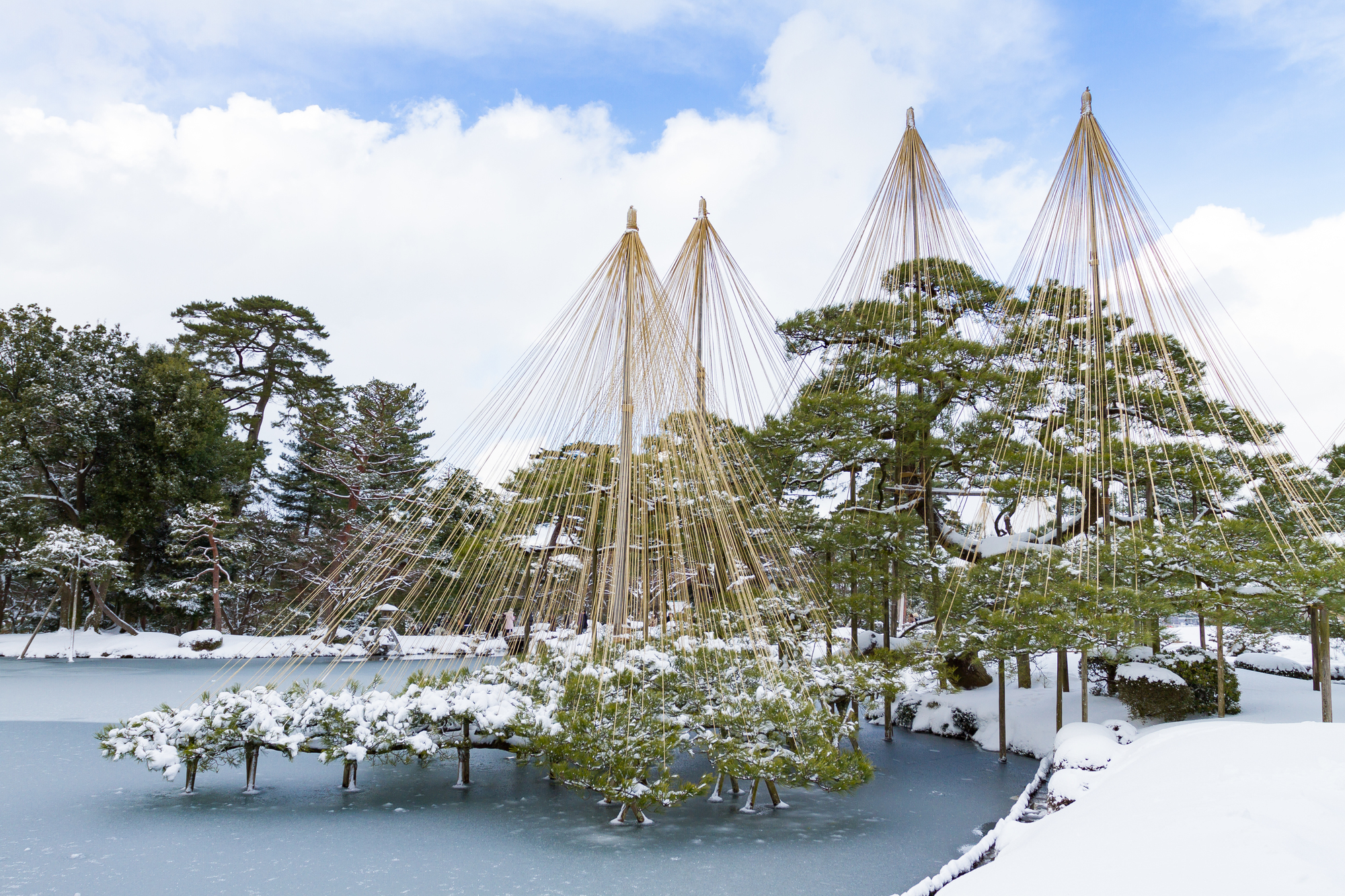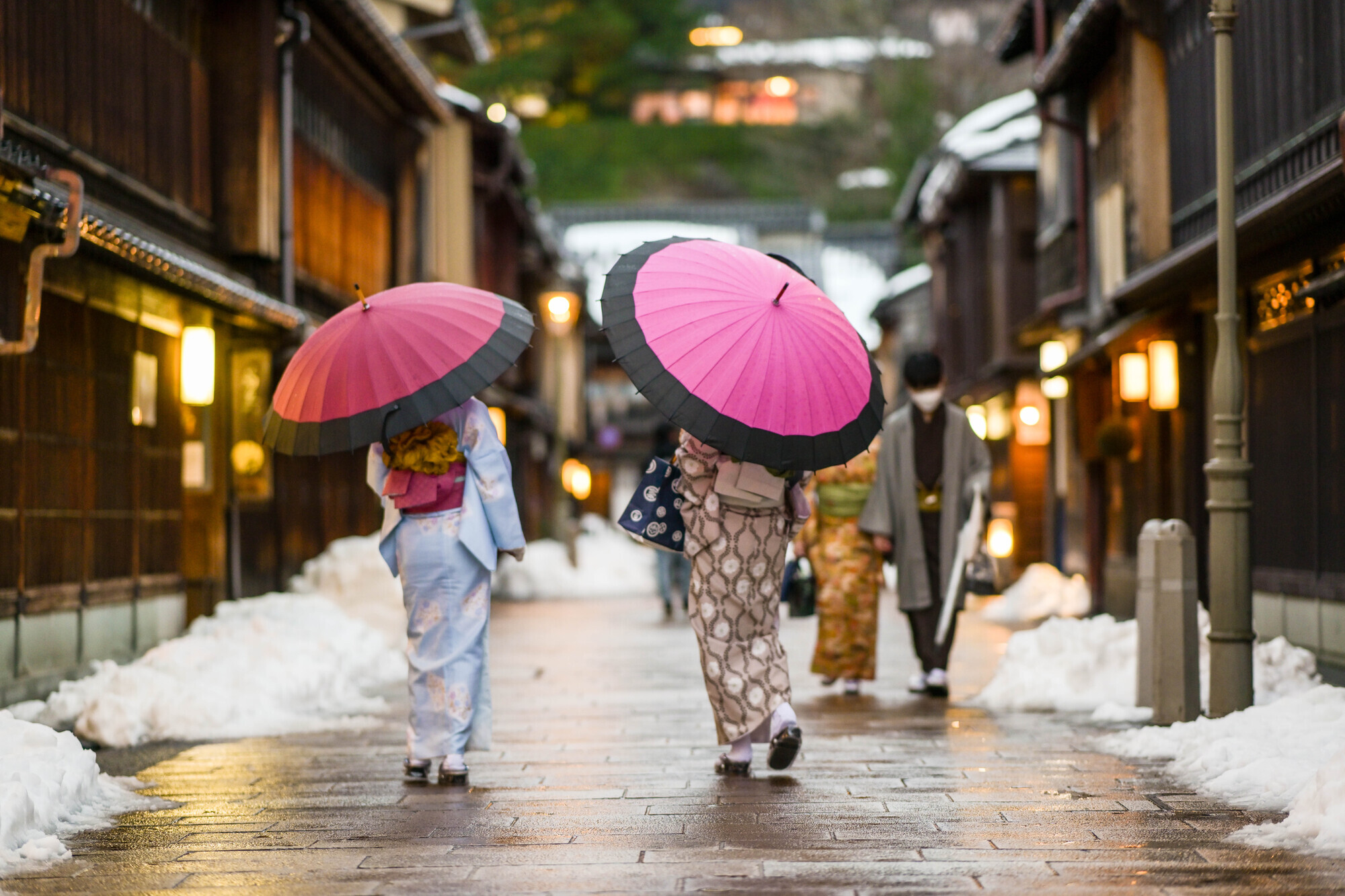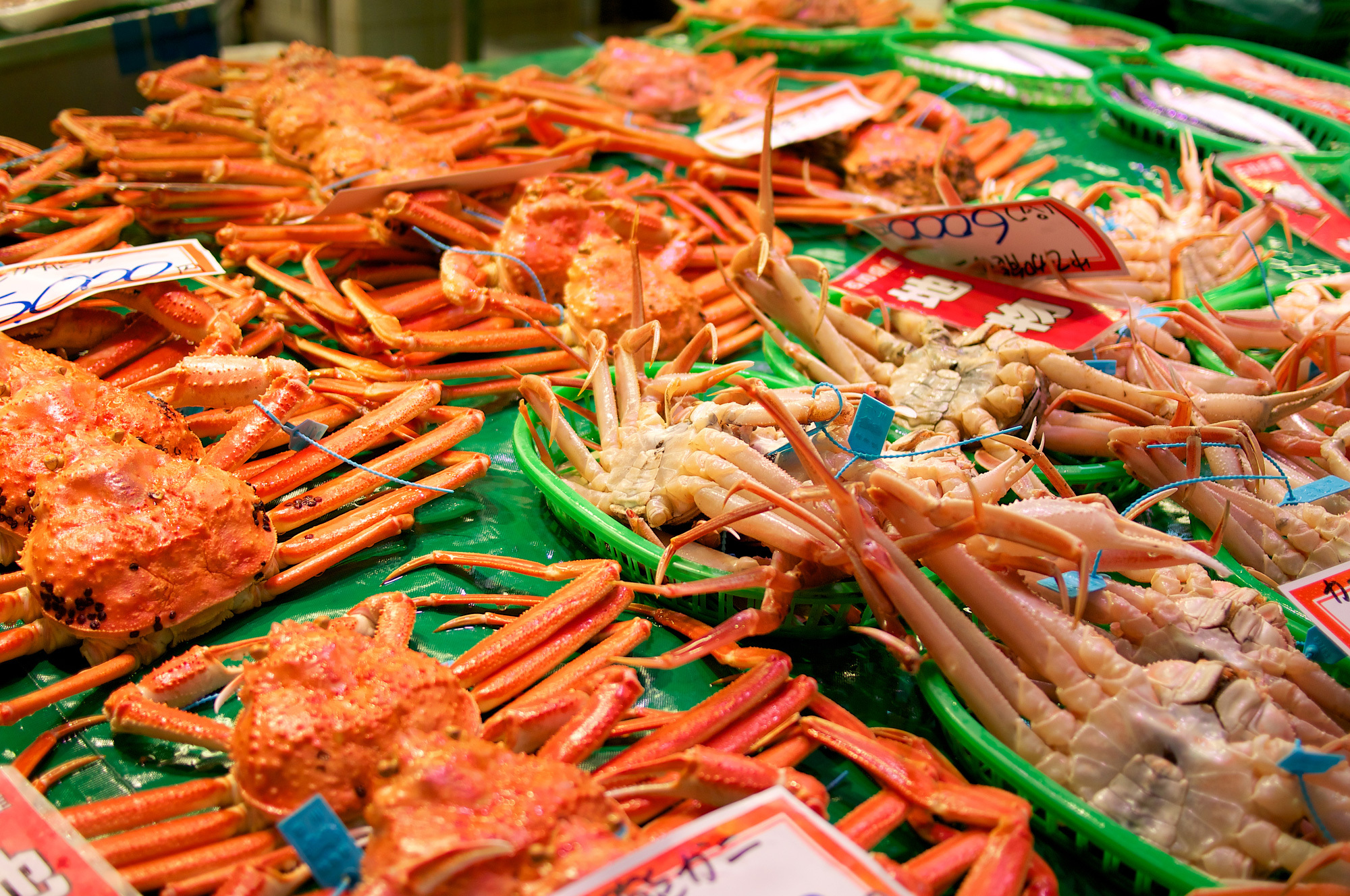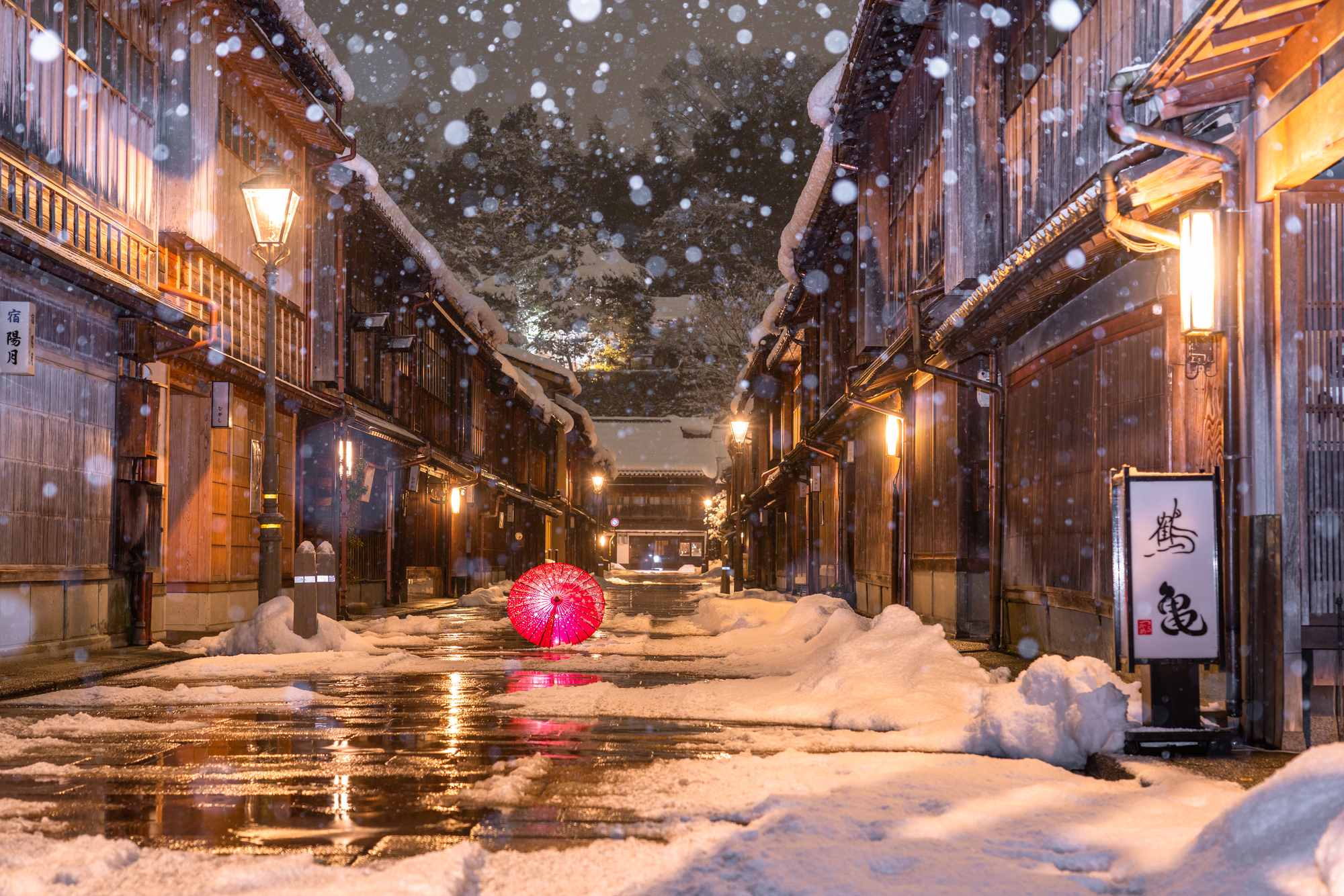Kanazawa Complete Guide
Elegant Etiquette to Observe in the City of Aesthetics
Table of Contents
Welcome to a "Living Museum." A Journey into Kanazawa's Aesthetics.

The sound of a shamisen echoing in a stone-paved alley, the tranquility of a samurai district with its earthen walls, and the geometric beauty of "Yukitsuri" ropes protecting garden trees from the weight of snow. Kanazawa is a city where the Japanese sense of beauty, refined over 400 years, breathes in every corner.
This city is not just an ancient capital where old things remain. While gorgeous traditional crafts are still being created by the hands of artisans, it is also a hub for contemporary art that attracts people from all over the world. Next to a historic chaya (teahouse) district, you'll find sophisticated cafes and select shops. Kanazawa is a "living museum" where past and present respect each other and merge beautifully.
This guide is both a map to efficiently tour Kanazawa's famous spots and a compass to feel the intangible "sense of beauty" that flows through the city and to behave as a gracious visitor. The manners introduced here are to help you embody the elegant atmosphere of this city yourself. To enjoy a sophisticated culture, sophisticated manners are required from those who receive it.
Now, sharpen your five senses. A deep and rich journey that will satisfy your intellectual curiosity and stimulate your aesthetic eye is about to begin.
1.The Legacy of "Kaga Hyakumangoku": Why Kanazawa's Culture Flourished
Before walking the streets of Kanazawa, knowing the historical background of why this land was able to cultivate such a rich culture will make your trip many times more interesting.
1-1. A Castle Town Spared from War: Why Do Old Townscapes Remain in Kanazawa?
While many Japanese cities suffered great damage from air raids during World War II, Kanazawa miraculously escaped major wartime destruction. As a result, the framework of the castle town from the Edo period, as well as historic districts like the chaya districts and samurai residences, still remain vividly today. The path you are walking on may be the very same path that samurai and townspeople traversed hundreds of years ago.
1-2. The Maeda Clan's Cultural Strategy: A World of Beauty Polished by Samurai and Artisans
During the Edo period, the Maeda clan of the Kaga Domain, which ruled this region, boasted immense economic power, known as "Kaga Hyakumangoku" (a domain with a million-koku rice stipend). The feudal lords invested this wealth not in military power, but in the promotion of scholarship, culture, and crafts. They invited top-class artisans from Kyoto and Edo, fostering a wide variety of traditional crafts such as gold leaf, Kaga Yuzen silk dyeing, Kutani ware pottery, and lacquerware. A climate that valued cultural refinement, such as samurai practicing the tea ceremony, created the sophisticated world of beauty unique to Kanazawa.
1-3. From Tradition to Modernity: The 21st Century Museum of Contemporary Art, Kanazawa, as a Symbol of "Evolving Tradition"
Kanazawa is not a city that merely preserves tradition. A symbol of this is the 21st Century Museum of Contemporary Art, Kanazawa, which opened in 2004. The circular, glass-walled building is based on the concept of a "museum open to the city like a park." The existence of this museum shows the world that Kanazawa is a city that continues to evolve, embracing new values and expressions while respecting its history and traditions.
1-4. [2025 Update] Evolving Ways to Explore Kanazawa and Sustainable Tourism
In recent years, Kanazawa has been promoting the dispersal of tourists as a measure against overtourism. Small-scale tours specializing in specific cultural experiences and promoting the charms of areas slightly away from the main tourist spots are gaining popularity. There are also increasing opportunities to visit traditional craft workshops, see artisans at work, and purchase crafts made from sustainable materials.
2.Preparations & Basic Info: Navigating the Ancient Capital Smartly
In Kanazawa, where attractions are concentrated, choosing an efficient mode of transport is key.
2-1. Complete Access Guide from Tokyo, Osaka, and Nagoya
- Shinkansen/Limited Express (Recommended):
From Tokyo:About 2.5 hours to Kanazawa Station by Hokuriku Shinkansen ("Kagayaki" or "Hakutaka").
From Osaka/Kyoto:Take the Limited Express “Thunderbird” to Tsuruga, then transfer to the Hokuriku Shinkansen to reach Kanazawa Station in as little as 2 hours and 9 minutes.
From Nagoya:Take the Limited Express “Shirasagi” to Tsuruga, then transfer to the Hokuriku Shinkansen to reach Kanazawa Station in about 2 hours and 30 minutes.
Kanazawa Station is a beautiful station, symbolized by its huge glass dome, the "Motenashi Dome," and the wooden "Tsuzumi-mon Gate."
2-2. Mastering the City's Transport Network: Loop Bus, Bike Sharing, and Walking
- Kanazawa Loop Bus: A circular bus that efficiently connects major tourist spots. The one-day pass is economical and convenient.
- Machi-nori (Bike Sharing): With ports located throughout the city, cycling around is pleasant on a fine day.
- Walking: Major spots like the Higashi Chaya District, Kenroku-en Garden, Kanazawa Castle Park, Omicho Market, and Nagamachi Samurai District are all within walking distance of each other. It's recommended to use the bus between areas and explore within each area on foot.
2-3. Autumn Leaves and Winter Snow: Seasonal Attire and Tips
- Autumn (November): The autumn foliage is at its peak. Days are pleasant, but it gets chilly in the morning and evening, so layered clothing is suitable.
- Winter (December-February): Snowy days are common, and the "Yukitsuri" in Kenroku-en Garden is a symbolic winter scene of Kanazawa. Full protection against the severe cold is necessary, including a down jacket, hat, and gloves. Waterproof, non-slip boots are essential. Be careful on snowy and icy roads.
3.[Crucial] To Be a Gracious Visitor in an Elegant City: 7 Manners to Keep in Kanazawa
To truly enjoy the beauty of Kanazawa, behavior that harmonizes with its aesthetic sense is required.
3-1. In the Chaya & Samurai Districts: Respect for Tranquility and Living Spaces
The alleys of the Higashi Chaya District and the Nagamachi Samurai District are still residential areas. Enjoy a quiet stroll without talking loudly or running. Do not touch the buildings or latticed doors without reason. When taking photos, be considerate not to include residents or other tourists without permission. Cultural Context: The aesthetic of "Iki" and sophisticated behavior. "Iki," an aesthetic from the Edo period, refers to a refined and effortless demeanor. In historic townscapes, behaving in an "iki" manner, by reading the atmosphere and blending in, is the mark of a good visitor. |
3-2. In Kenroku-en Garden: Etiquette for Not Damaging the Gardeners' Artwork
Kenroku-en, one of Japan's three most beautiful landscape gardens, is a living work of art created over many years. Do not touch the moss, plants, or trees, or enter fenced-off areas. The winter "Yukitsuri" are the fruit of the gardeners' skill and love, installed to prevent branches from breaking under the weight of snow. Appreciate them with an understanding of their meaning and with respect. Cultural Context: "Beauty in utility" and "wabi-sabi." The Japanese view of nature seen in Yukitsuri. Yukitsuri embodies the Japanese spirit of "Yo-no-bi" (beauty in utility), finding ultimate beauty in something practical—protecting the trees. Its quiet presence in the harsh winter nature also evokes the spirit of "wabi-sabi," finding beauty in imperfection. |
3-3. In Omicho Market: Consideration for Not Disturbing the "Citizens' Kitchen"

Omicho Market, affectionately known as "Omicho," is both a tourist spot and a "kitchen" for local chefs and citizens. Avoid blocking the narrow aisles with large luggage or touching products without reason. If you buy street food, eat it in front of the shop or in a designated area. Eating while walking is prohibited. Cultural Context: The dual nature of a market, "hare" and "ke". For tourists, a market is a place of "hare" (the extraordinary), but for the workers and local shoppers, it is a place of "ke" (the ordinary). It's important to act with the awareness that you are a guest in their "ke" space and not get in their way. |
3-4. At the 21st Century Museum of Contemporary Art: Rules for Enjoying a Dialogue with Art
A charm of this museum is that many works can be touched and experienced, but not all of them. Always check the notes next to the artwork. For popular works like Leandro Erlich's "The Swimming Pool," be considerate and share the viewing and photo opportunities. Cultural Context: The boundary between "participation" and "appreciation" in contemporary art. Even in art that encourages "participation," there are rules intended by the artist. Understanding and respecting these rules leads to a deeper dialogue with the work. |
3-5. Experiencing Traditional Crafts: Respect for Artisans and Manners for "Looking and Buying"
Kanazawa has many shops handling wonderful traditional crafts. These items are the result of artisans' long hours and passion. Handle them with respect and care. Avoid occupying items for a long time if you do not intend to buy them, or entering shops just for a casual look. Cultural Context: The Japanese culture of respecting artisans ("Takumi"). In Japan, there is a culture of deeply respecting artisans ("Takumi") with outstanding skills. Touching their work is the same as touching their skill and spirit. Keep that in mind. |
3-6. Walking in a Kimono: Demeanor Befitting the Attire
The streets of Kanazawa are very scenic for walking in a kimono, and kimono rentals are popular. When you wear a kimono, your posture naturally straightens, and your stride becomes smaller. By being a little conscious not to walk with large steps or get the hem dirty, you can look more beautiful and also treat the kimono itself with care. Cultural Context: The "kata" (form) that kimono demands, and the accompanying state of mind. In Japanese traditional culture, such as kimono, tea ceremony, and martial arts, there is "kata" (form). It is believed that by being conscious of the "kata," not only does one's conduct become beautiful, but the mind also calms, allowing one to approach the spirituality of the culture. |
3-7. Savoring Winter Delicacies: Gratitude for Seasonal Blessings and Dining Etiquette
Winter in Kanazawa is a treasure trove of gourmet food, such as Kano-gani crab and Kan-buri (winter yellowtail). In high-end ryotei (traditional Japanese restaurants) and sushi restaurants, appropriate attire and quiet conversation are expected. Before a meal, say "Itadakimasu" with your hands together to express gratitude for the life of the ingredients and for everyone who brought them to you. Cultural Context: The gratitude embodied in "Itadakimasu". "Itadakimasu" is not just a signal to start eating. It is a fundamental word in Japanese food culture, embodying the meaning "I humbly receive this life" from the plants and animals that became the food, and gratitude to everyone involved, from farmers and fishermen to the chef. |
4-1. Area-Specific Walking Guide: Higashi Chaya, Nagamachi, and Kazuemachi
- Higashi Chaya District: The largest chaya district in Kanazawa. Beautiful chaya architecture with latticed windows line the streets, filled with cafes and souvenir shops.
- Nagamachi Samurai District: A former residential area of samurai, with its ocher earthen walls and stone pavements. In winter, you can see "komo-gake" straw mats protecting the walls from snow.
- Kazuemachi Chaya District: A small, atmospheric chaya district along the Asano River. The evening lights are particularly beautiful.
4-2. The Kings of Winter Delicacies: Savoring Kano-gani Crab and Kan-buri Yellowtail

4-3. Finding Your Own Kanazawa: Gold Leaf and Wagashi Making Workshops
Kanazawa offers many workshops where you can easily experience traditional crafts. The "gold leaf application experience," where you can make your own original gold-leaf plate or chopsticks, is particularly popular in Kanazawa, which accounts for over 99% of domestic gold leaf production. The "wagashi (Japanese confectionery) making experience," where you create beautiful sweets nurtured by the tea ceremony culture, is also recommended.
5.Planning Your Trip: Model Itineraries Where Tradition Meets Modernity
5-1. [1 Night, 2 Days] Kanazawa Golden Route! A Classic Course Covering Major Spots
- Day 1: Arrive at Kanazawa Station → Lunch with a seafood bowl at Omicho Market → Stroll through the Higashi Chaya District, take a break at a Japanese cafe → Kenroku-en Garden (autumn illumination is also available) → Check into a hotel in the city.
- Day 2: Stroll through the Nagamachi Samurai District → Appreciate art at the 21st Century Museum of Contemporary Art, Kanazawa → Souvenir shopping at Kanazawa Station, then head home.
5-2. [2 Nights, 3 Days] Mastering Winter in Kanazawa! A Luxurious Course Immersed in Gastronomy and Aesthetics
- Day 1:Arrive at Kanazawa Station → Stroll through Higashi Chaya District and try a gold leaf workshop → Dinner at a secluded kappo restaurant in the Kazuemachi Chaya District → Stay at a hotel in the city.
- Day 2:Enjoy winter delicacies at Omicho Market in the morning → Appreciate the Yukitsuri at Kenroku-en Garden in the afternoon → Stroll through Nagamachi Samurai District → Splurge on a full-course Kano-gani crab dinner at night.
- Day 3:Visit the 21st Century Museum and the D.T. Suzuki Museum to touch upon Kanazawa's spirituality → Try a wagashi making workshop → Head home.
The "Beauty in Utility" of Kanazawa to Take Home with You

What you take home from your trip to Kanazawa will likely be more than just memories of beautiful crafts and delicious sweets. It will be a unique Japanese aesthetic, "Yo-no-bi" or "beauty in utility"—the beauty that resides in practical things, just as the "Yukitsuri" that protects trees from snow possesses an artistic beauty.
Your act of observing manners and respecting the culture in this city is not mere rule-following. It is you yourself becoming a part of Kanazawa's elegant atmosphere, practicing the "beauty in utility" that will connect the beauty of this "living museum" to the future.

